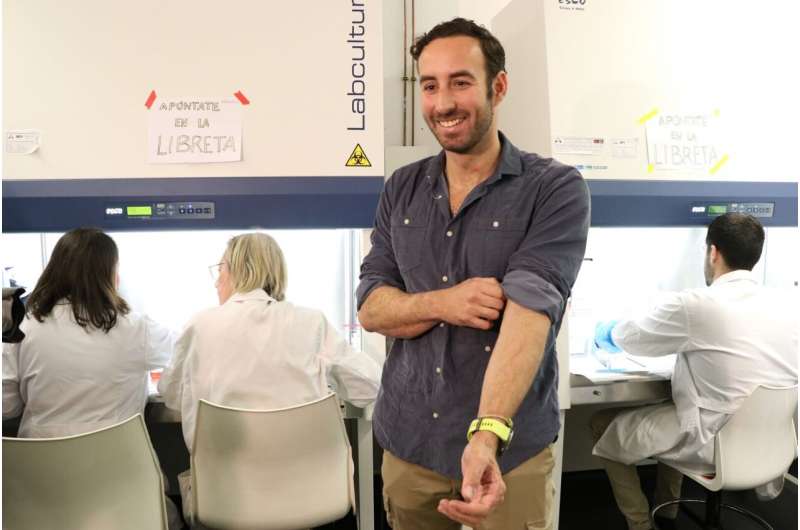This article has been reviewed according to Science X's editorial process and policies. Editors have highlighted the following attributes while ensuring the content's credibility:
fact-checked
peer-reviewed publication
trusted source
proofread
Assessing the efficacy and viability of artificial skin in patients with severe burns

UGR scientists have demonstrated the efficacy and viability of the artificial skin UGRSKIN, an advanced therapy medicinal product (ATMP) they developed in 2012, which has proven to be highly beneficial in the treatment of patients with major burns. Moreover, it does not cause any side effects or significant complications.
The Tissue Engineering Research Group of the Department of Histology at the UGR's Faculty of Medicine and the Biohealth Research Institute in Granada—a pioneering group in the design and manufacture of artificial human tissues—invented and unveiled an artificial skin model called UGRSKIN in 2012. The model is based on human skin cells and natural biomaterials developed by the research group.
The research team was able to demonstrate the efficacy of the skin model in laboratory animals and develop all the quality controls necessary for its characterization, in accordance with the requirements of the relevant regulatory agencies.
Subsequently, having demonstrated the potential usefulness of the UGRSKIN model, the UGR team, in close collaboration with the Regional Government of Andalusia's Network for Design and Translation of Advanced Therapies (RAdytTA), was able to manufacture this pharmaceutical-grade artificial skin for use as an advanced therapy medicinal product (ATMP), in accordance with the regulations of the Spanish Agency of Medicines and Medical Devices (AEMPS) and existing European quality standards.
Following its approval by the AEMPS, UGRSKIN was used for the first time in 2016 to treat a patient with severe burns on 70% of their body at the leading burn unit in Andalusia, located at the Virgen del Rocío University Hospital in Seville, with good results. Since then, a total of 15 patients (eight adults and four children) have been treated, with an overall survival rate of almost 80%.
At a press conference held at the UGR's Faculty of Medicine, where the artificial skin was designed, the research team presented their follow-up and histological analysis of the first 12 patients treated with UGRSKIN. These results led to the research article "Histological assessment of nanostructured fibrin-agarose skin substitutes grafted in burnt patients. A time-course study," published in Bioengineering & Translational Medicine.
"Once implanted, the UGRSKIN model quickly fused with the patient's tissue and almost immediately formed an epidermis very similar to the normal human epidermis, thus helping to protect the patient from possible external pathogens. In addition, two months after implantation, the dermis of the implanted tissue was able to progressively remodel itself until it became histologically similar to the normal dermis," explains Professor Miguel Alaminos.
Treating patients with severe burns is a major health care challenge. Despite the advances of modern medicine, the survival rate of patients with deep burns over large areas of the body is still very low. It is therefore necessary to develop new, truly effective treatments for these cases, such as the artificial skin developed at the UGR.
The preliminary results of the project presented at the UGR have been announced at international forums in Berlin, Zurich, Nantes and Shanghai. As a result of this breakthrough, the next meeting of the European Skin Tissue Engineering Network for Major Burns will be organized in Granada in June 2024 by the Tissue Engineering Research Group.
The patients treated with the UGRSKIN artificial skin have experienced an improvement in their quality of life, and some have even managed to overcome challenges and difficulties, such as climbing high mountains and participating in demanding sports competitions.
The UGR press conference (which was chaired by the Rector of the UGR, Pedro Mercado) was attended by Álvaro Trigo Puig, one of the patients who received the artificial skin implant in 2018.
Álvaro is a 28-year-old from Madrid who suffered burns to 63% of his skin in a serious fire in 2018. His injuries left him in a coma for 10 days and he spent four months in the Virgen del Rocío University Hospital in Seville.
Since receiving the artificial skin implant designed at the UGR, Álvaro Trigo has organized and carried out long-distance sports events for charity. Among other feats, he has climbed Mount Kilimanjaro and Mont Blanc, and swum across the Strait of Gibraltar, between Formentera and Ibiza, and from the Cíes Islands to Vigo (Galicia) with his feet chained together.
More information: Miguel Angel Martin‐Piedra et al, Histological assessment of nanostructured fibrin‐agarose skin substitutes grafted in burnt patients. A time‐course study, Bioengineering & Translational Medicine (2023). DOI: 10.1002/btm2.10572




















